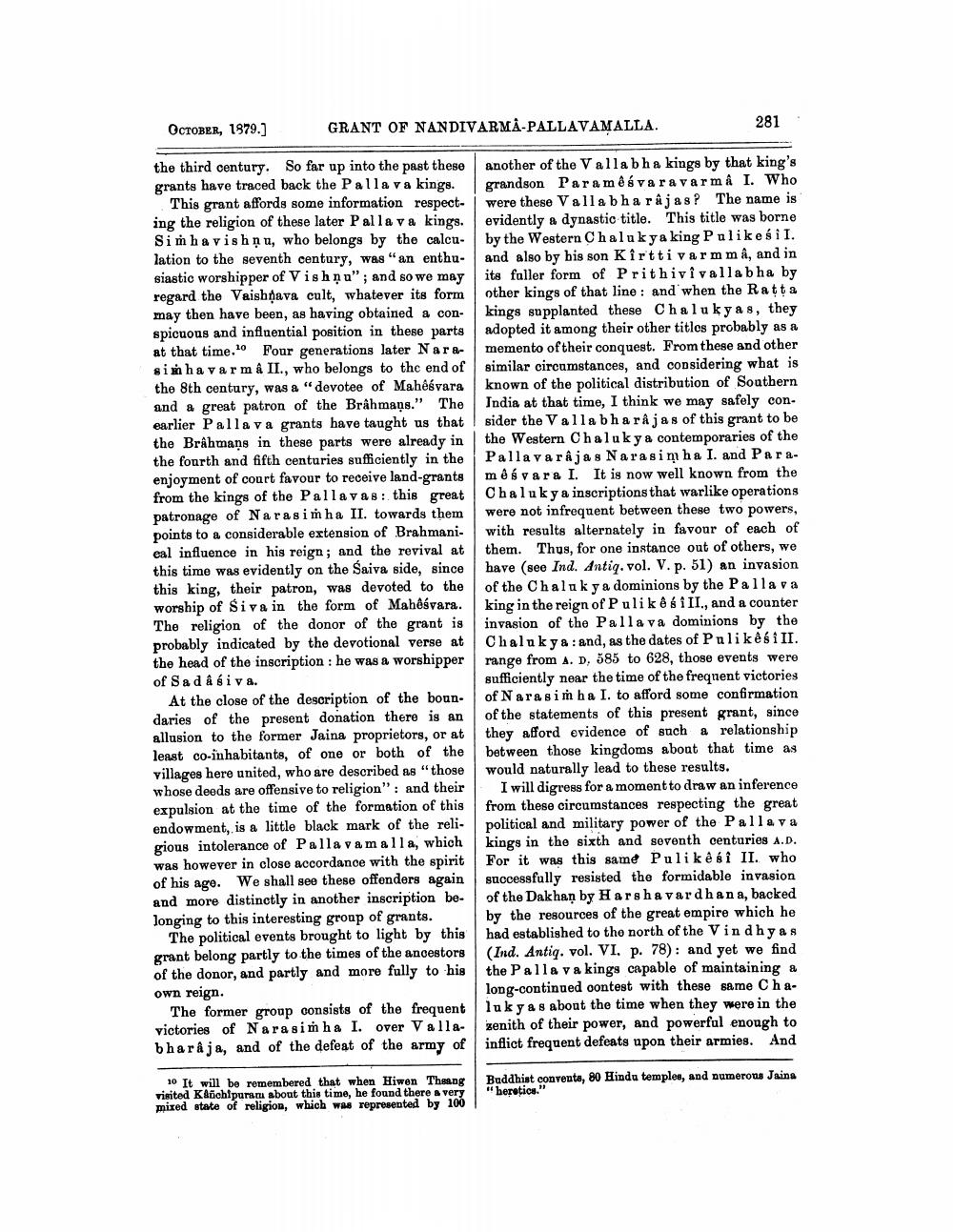________________
OCTOBER, 1979.)
GRANT OF NANDIVARMA-PALLAVAMALLA.
281
the third century. So far up into the past these another of the Vallabh a kings by that king's grants have traced back the Palla va kings. grandson Para més vara varm & I. Who
This grant affords some information respect- were these Vallabha râjas? The name is ing the religion of these later Palla va kings. evidently a dynastic title. This title was borne Simha vishnu, who belongs by the calcu. by the Western Chaluk ya king Pulikesil. lation to the seventh century, was an enthu- and also by his son Kirtti varmma, and in siastic worshipper of Vishnu"; and so we may its faller form of Prithivi vallab ha by regard the Vaishnava cult, whatever its form other kings of that line: and when the Ratta may then have been, as having obtained a con- kings supplanted these Chalukyas, they spicuous and influential position in these parts adopted it among their other titlos probably as a at that time. Four generations later Nara- memento of their conquest. From these and other sinha varm & II., who belongs to the end of similar circumstances, and considering what is the 8th century, was a “devotee of Mahêśvara known of the political distribution of Southern and a great patron of the Brâhmaņs." The India at that time, I think we may safely con. earlier Pallava grants have taught us that sider the Vallabha rå jas of this grant to be the Brâhmans in these parts were already in the Western Chalukya contemporaries of the the fourth and fifth centuries sufficiently in the Pallava râjas Narasimha I. and Paraenjoyment of court favour to receive land-grants mês vara I. It is now well known from the from the kings of the Pallavas: this great Chaluky a inscriptions that warlike operations patronage of Narasimha II. towards them were not infrequent between these two powers, points to a considerable extension of Brahmani- with results alternately in favour of each of eal influence in his reign; and the revival at them. Thus, for one instance out of others, we this time was evidently on the Saiva side, since have (see Ind. Antiq. vol. V. p. 51) an invasion this king, their patron, was devoted to the of the Chaluky a dominions by the Palla va worship of Siva in the form of Mahôśvara. king in the reign of Puli kê sill, and a counter The religion of the donor of the grant is invasion of the Palla va dominions by the probably indicated by the devotional verse at Chalukya: and, as the dates of Pulikesi II. the head of the inscription : he was a worshipper range from A. D, 585 to 628, those events were of Sadasiva.
sufficiently near the time of the frequent victories At the close of the description of the boun. of Narasimha I. to afford some confirmation daries of the present donation there is an of the statements of this present grant, since allusion to the former Jaina proprietors, or at they afford evidence of such a relationship least co-inhabitants, of one or both of the between those kingdoms about that time as villages here united, who are described as "those would naturally lead to these results. whose deeds are offensive to religion": and their I will digress for a moment to draw an inference expulsion at the time of the formation of this from these circumstances respecting the great endowment, is a little black mark of the reli- political and military power of the Pallava gious intolerance of Palla vamalla, which kings in the sixth and seventh centuries A.D. was however in close accordance with the spirit For it was this same Pulike bi II. who of his age. We shall see these offenders again successfully resisted the formidable invasion and more distinctly in another inscription be- of the Dakhan by Harsha vardhana, backed longing to this interesting group of grants. by the resources of the great empire which he
The political events brought to light by this had established to the north of the Vindhyas grant belong partly to the times of the ancestors (Ind. Antiq. vol. VI. p. 78): and yet we find of the donor, and partly and more fully to his the Palla va kings capable of maintaining a own reign.
long-continued oontest with these same Cha. The former group consists of the frequent luk yas about the time when they were in the victories of Narasimha I. over Valla- zenith of their power, and powerful enough to bharaja, and of the defeat of the army of inflict frequent defeats upon their armies. And
10 It will be remembered that when Hiwen Theang visited Klöchipuram about this time, he found there a very mixed state of religion, which was represented by 100
Buddhist conventa, 80 Hindu temples, and numerous Jains "beretice."




